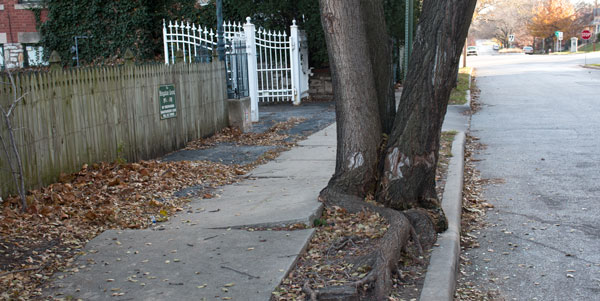In this final report in the MidtownKC Walks series, the call for change in Kansas City. In the first story, Kansas City residents, especially those in Midtown, said they are more dissatisfied with the condition of sidewalks than almost any other city service. We’ve also reported that residents said they are surprised to learn that responsibility for sidewalk maintenance lies with individual property owners and discussed the various reasons sidewalks are becoming more important to people in Midtown. Yesterday, we heard what other cities are doing about sidewalk policies.
MidtownKC Walks Project is a joint project of the Midtown KC Post, BikeWalkKC and The Whole Person. Join a conversation about sidewalks on the Midtown KC Walks page or comment on these stories. We also have a survey about your experiences walking in Midtown and a map where you can mark sidewalk problems you encounter. Join the MidtownKC Walks mailing list for updates on the project.
Kansas City Mayor Pro Tem Scott Wagner is well aware of problems with Kansas City sidewalks. Now in his second term on the council, Wagner has heard the complaints about sidewalk conditions from citizens and faced the limited amount of dollars available in the city budget.
“There are two main problems,” he says. “We can’t get sidewalks built or repaired quickly enough. And the property owner usually pays.”
So if the city understands the problem, why haven’t sidewalk complaints diminished?
“Part of the problem is the scale and the scope of the problem and the money to deal with the issue,” Wagner says.
Kansas City has 2200 miles of sidewalks and currently repairs about two miles per year. The public works department estimates that about 159 miles are out of compliance with industry standards and 2200 miles are at risk. The current lag time between when a sidewalk problem is reported and when repairs are made is between two and three years.
Kansas City developed a Walkability Plan in 2003, pointing out that ”pedestrian facilities are overlooked or sidewalks merely added as part of street improvement projects. However, to preserve and enhance the quality of life in the urbanized areas of the region, consistent maintenance of the existing pedestrian systems and additional facilities are needed.”
A city audit on the sidewalk replacement program in 2006 concluded Kansas City does not manage its sidewalk assets well. It faulted the city for not having a systematic inspection program, and for only inspecting sidewalk conditions when a citizen initiates a request or makes a complaint.
The audit was also critical of the policy placing financial responsibility on property owners. A 2001 survey had shown that 68 percent of property owners didn’t even know they were responsible for sidewalk repair – they thought the city shouldered that burden. It cited another city survey that said 45 percent said the city and property owners should split the cost of sidewalk repairs. And it pointed out a variety of different programs used to pay for sidewalk repairs that meant some property owners paid the full cost while others paid nothing.
Auditors also made a number of suggestions for improving the system. Key among them was that the city needs a systematic program to monitor and track conditions rather than waiting for a complaint to trigger repairs. It called the current system fragmented and said it was difficult for property owners to understand. It also suggested better communication with property owners about their role in sidewalk maintenance.
Since then, there have been internal changes within city hall aimed at improving the system. Wagner says the city has extended the time property owners have to pay back the city from 10 years to 15 years, an effort to ease the financial burden. The city will also do a project this spring with NeighborhoodWorks to train workers to do simple concrete work in an effort to get repairs done more quickly. The city has been working to notify property owners of the potential need for repairs earlier.
But for pedestrian advocates like Eric Bunch of BikeWalkKC, the time has come to move sidewalks to the front of the city agenda. He thinks Kansas City residents have accepted the poor state of sidewalks assuming “that’s just the way it is.”
“The city says it wants to be pedestrian friendly,” he says, “But what is it doing? What has it actually done, rather than just pay lip service to the plans?”
Wagner says so far the city improvements have focused on informing people about sidewalk policy and their responsibility for maintenance. Meantime, he’s been studying sidewalk policy in other cities and he thinks the time has come to face the really tough questions – how to speed up repairs and how to fund ongoing sidewalk maintenance.
“The ultimate question is are we as citizens prepared to finance sidewalks in the way they need to be financed? I intend to pose that question,” he said.
Wagner is aware that many people find the current practice of asking people to spend thousands of dollars to repair their own sidewalks unfair. He thinks its time to ask voters if they would support a change.
“Do I mind spending $5 to $10 a year so my neighbor doesn’t get stuck with a $4000 bill?“ he asks.
Bunch at BikeWalkKC agrees the time has come to consider a policy change. He suggests the city should consider homeowner incentives, subsidies for people who can’t afford repairs, or even cost-shifting to joint city-property owner funding. Although he admits that shifting more city funds into sidewalk maintenance would involve growing pains, he thinks the time has come to fix a system that seems to be broken.
“If this is really a priority, we need to figure out a way to make it happen,” he says.




Who’s talking